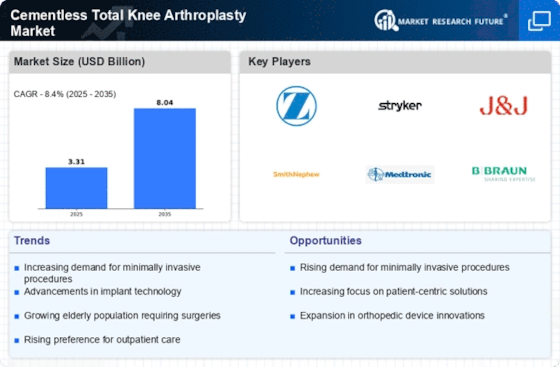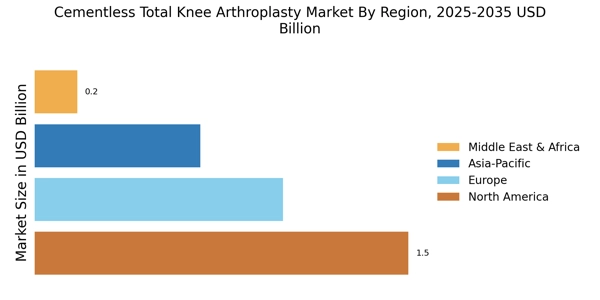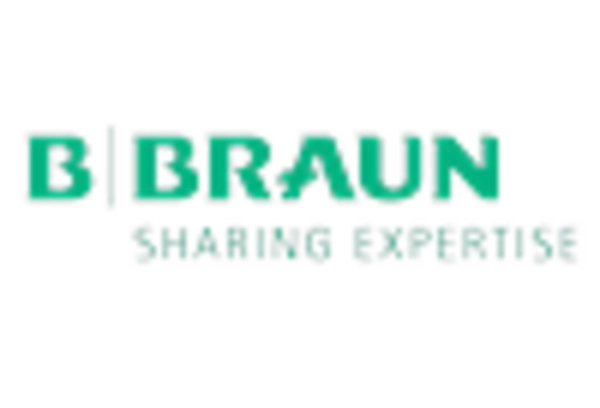Growing Geriatric Population
The Cementless Total Knee Arthroplasty Market is significantly influenced by the growing geriatric population, which is more susceptible to joint disorders and requires surgical interventions. As life expectancy increases, the number of elderly individuals is projected to rise, leading to a higher incidence of conditions necessitating knee replacements. Data suggests that by 2030, the number of individuals aged 65 and older will reach approximately 1.5 billion, creating a substantial market for orthopedic procedures. This demographic trend is prompting healthcare systems to invest in advanced surgical options, including cementless total knee arthroplasty, which is favored for its potential to enhance patient recovery and satisfaction. Consequently, the Cementless Total Knee Arthroplasty Market is expected to thrive in response to this demographic shift.
Rising Prevalence of Osteoarthritis
The Cementless Total Knee Arthroplasty Market is experiencing growth due to the increasing prevalence of osteoarthritis, a degenerative joint disease that affects millions worldwide. As the population ages, the incidence of osteoarthritis is expected to rise, leading to a higher demand for knee replacement surgeries. According to recent data, osteoarthritis affects approximately 10% of men and 18% of women over the age of 60. This demographic shift is likely to drive the need for effective treatment options, including cementless total knee arthroplasty, which offers advantages such as improved bone integration and reduced risk of implant loosening. Consequently, the Cementless Total Knee Arthroplasty Market is poised for expansion as healthcare providers seek to address the growing burden of joint-related ailments.
Enhanced Focus on Rehabilitation and Recovery
The Cementless Total Knee Arthroplasty Market is also being driven by an enhanced focus on rehabilitation and recovery protocols following knee surgeries. As healthcare providers emphasize the importance of post-operative care, the demand for cementless total knee arthroplasty is likely to increase. These procedures are often associated with shorter recovery times and improved functional outcomes, which align with the current trends in patient-centered care. Rehabilitation programs are increasingly incorporating evidence-based practices that support faster recovery, thereby encouraging the adoption of cementless techniques. Market analysis indicates that facilities prioritizing comprehensive rehabilitation strategies are more likely to report higher patient satisfaction rates, further propelling the Cementless Total Knee Arthroplasty Market forward.
Technological Innovations in Surgical Techniques
Technological advancements in surgical techniques are significantly influencing the Cementless Total Knee Arthroplasty Market. Innovations such as robotic-assisted surgery and computer navigation systems enhance precision during procedures, leading to better patient outcomes. These technologies allow for more accurate implant placement and alignment, which are critical factors in the success of knee arthroplasties. As a result, hospitals and surgical centers are increasingly adopting these advanced techniques, contributing to the growth of the cementless knee arthroplasty segment. Market data indicates that the adoption of robotic systems in orthopedic surgeries is expected to grow at a compound annual growth rate of over 20% in the coming years, further solidifying the role of technology in the Cementless Total Knee Arthroplasty Market.
Increasing Awareness of Alternative Treatment Options
The Cementless Total Knee Arthroplasty Market is benefiting from a growing awareness of alternative treatment options for knee-related issues. Patients are becoming more informed about the benefits of cementless implants, which are perceived to offer better long-term outcomes compared to traditional cemented options. This shift in patient perception is encouraging orthopedic surgeons to recommend cementless procedures more frequently. Additionally, educational campaigns and patient advocacy groups are playing a crucial role in disseminating information about the advantages of cementless total knee arthroplasty, such as reduced recovery times and improved mobility. As awareness continues to rise, the Cementless Total Knee Arthroplasty Market is likely to see an increase in demand for these innovative solutions.


















Leave a Comment